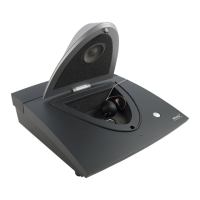Affinity
2.0
Additional Information Page 134
The level of the TEN in dB HL can be set using the computer mouse, by clicking the appropriate point on the
screen, or by using the appropriate knob on the optional dedicated keyboard. Initially, the TEN is turned off
while the appropriate level is selected. Some useful rules for selecting the level of the TEN are as follows:
1) For frequencies where the hearing loss is less than or equal to 60 dB, set the TEN level to 70 dB. This is
not unpleasantly loud for most people, and it leads to a definitive result.
2) When the hearing loss is 70 dB or more at a given frequency, set the TEN level 10 dB above the
audiometric threshold at that frequency. For example, if the audiometric threshold is 75 dB HL, set the TEN
level to 85 dB HL.
3) If the TEN is found to be unpleasantly loud, or if the maximum TEN level of 90 dB HL is reached, then the
TEN level can be set equal to the audiometric threshold. This should still give a definitive result.
It may be difficult or impossible to apply the TEN(HL) test when the hearing loss at the test frequency is 90
dB or more, although it is quite likely that a dead region would be present with such a severe hearing loss.
Note that the TEN level does not need to be the same for all test frequencies. Once the level is chosen for a
given test frequency, the TEN is turned on continuously, by placing the cursor over “stimulus” or by clicking
on “Rev”.
The threshold for detecting a test signal in the TEN is determined using the same procedure as would be
used for manual audiometry, except that a step size in level of 2 dB should be used when the tone is in the
region of the detection threshold; larger steps can be used initially, to find the approximate threshold. 2-dB
steps are automatically selected when the TEN(HL) test is chosen from the drop-down menu. The use of
small steps makes the outcome more precise, and reduces the incidence of false positives.
15
Once the
threshold has been measured for a given test frequency, the appropriate TEN level is set for the next test
frequency, and the process is repeated.
For a person with normal hearing, the threshold of the test tone in the TEN is typically equal to the TEN level.
For example, if the TEN level is set to 70 dB HL, the threshold for detecting the test tone is about 70 dB HL,
for any frequency from 500 to 4000 Hz. If a patient has a cochlear hearing loss but does not have a dead
region at the test frequency, then the threshold of the test tone in the TEN is typically a few dB above the
TEN level. For example, if the TEN level is set to 70 dB HL, the threshold for detecting the test tone might
be 73 dB HL. However, when the test tone frequency falls in a dead region, the threshold for detecting the
test tone in the TEN is typically well above the TEN level. The criteria for diagnosing a dead region at a
specific frequency are:
1) The threshold of the test tone in the TEN is 10 dB or more above the TEN level.
2) The threshold of the test tone in the TEN is 10 dB or more above the audiometric (absolute) threshold.
If the TEN level is selected as described earlier, then criterion 2) will automatically be satisfied when criterion
1) is satisfied.
Figure 4 is a screen shot from the Affinity system, showing audiometric thresholds (circles) and TEN(HL)-test
results (“TEN” symbols) for a person with good low-frequency hearing but a severe high-frequency hearing
loss. The results suggest that this patient has a dead region extending upwards from 1.5 kHz.
It typically takes about 4 minutes per ear to perform the TEN(HL) test for all test frequencies. In practice, it is
usually not necessary to conduct the TEN(HL) test for frequencies where the hearing loss is 50 dB or less.
For example, if a patient has a typical sloping hearing loss, with relatively good hearing at low frequencies
and poor hearing at high frequencies, it is only necessary to conduct the test for the medium and high
frequencies. However, if the patient has an unusually shaped audiogram, such as a localized mid-frequency
loss, it may be worth conducting the TEN(HL) test even when the loss is mild.
Clinical Applications of the TEN(HL) Test
The presence or absence of dead regions can have important implications for fitting hearing aids and for
predicting the likely benefit of hearing aids. When a patient has a dead region, there may be little or no
benefit in applying amplification (via a hearing aid) for frequencies well inside the dead region. However, for
patients with high-frequency dead regions, there may be some benefit in applying amplification for
frequencies up to about 1.7fe.
16,17
For example, if a patient has a dead region which starts at 1000 Hz and
extends upwards from there, there may be some benefit in amplifying frequencies up to 1700 Hz. However,
there will probably be no benefit of applying amplification for frequencies above about 1700 Hz. Trying to
achieve sufficient gain for frequencies above 1700 Hz might lead to problems with distortion and acoustic
feedback. For a patient with an extensive high-frequency dead region, a hearing aid incorporating frequency
transposition or frequency compression might be a viable option.
18,19

